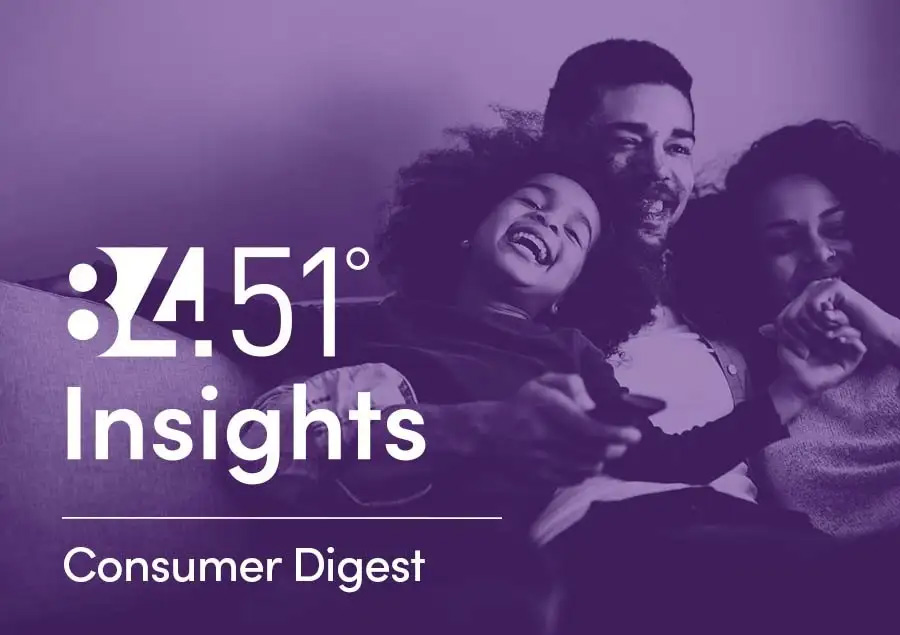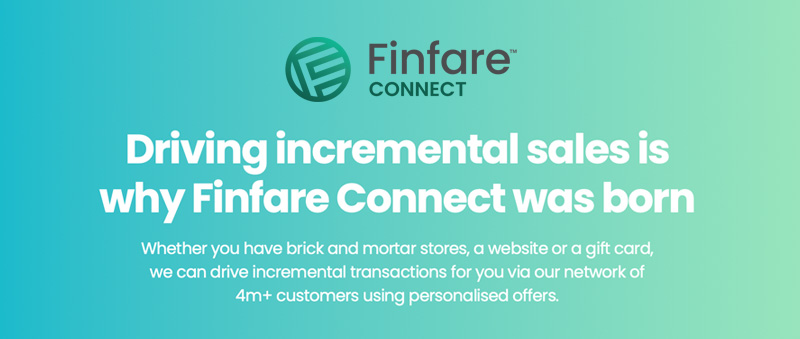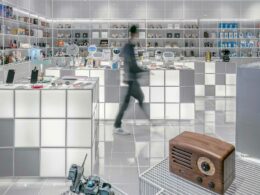We recently got to chat with Alex Trott to explore how Kroger works its data magic. We unpacked the journey from overlooked emails to a game-changing partnership that shook up the grocery scene. Take a stroll down memory lane, from Kroger’s early days with Dunnhumby to the birth of 84.51°, and see how these moves flipped the script for the grocery industry.
As we chat with Alex, we’ll discover how Kroger’s marketing game leveled up with Precision Marketing. We’ll also dive into how traditional grocery shopping holds its ground against the digital wave, and what the numbers really say about our shopping habits today.
Spoiler alert: despite all the buzz about online shopping, it turns out most folks still prefer hitting the aisles in person. We’ll dig into Kroger’s bag of tricks, like digital coupons that make sure you never miss a deal. And let’s not forget about what’s next in grocery—think specialized delivery services and fresh produce online.
So, grab a seat and let’s talk grocery—the future’s looking pretty interesting!
This episode of Customerland is sponsored by
Read the full transcript below
Alex Trott
Yes, so thanks for the introduction there. I have been with this organization in some form or another, so through 84.51° or Dunnhumby USA, for over a decade, so 12 years, which is an accomplishment, but it’s also a unique journey that I’ve been on because I’m someone in our current organization that was also part of Dunnhumby USA of the past, and I think the comment that I wanted to make here an interesting point is it is useful to understand the heritage of Dunnhumby and how that came to be with Kroger and their background, to understand where we are today and in the past, without going into too much detail, kroger approached Dunnhumby and said, hey, we have all of this household data. What should we do with it? It took them a while to get that, even first meeting off the ground, but they did. This is a British company and they realized that Kroger had loads of first household data and they needed to figure out a way to use that.
So back in those days it was very simple and the point I wanted to make was that they learned that using this data to protect, reward, inspire Kroger’s loyal shoppers would actually be the thing that would grow their business, going out and acquiring a bunch of new shoppers left and right really wasn’t the right strategy that they learned. It was all about retaining their loyal base and growing the loyal base because Kroger had so many wonderful shoppers. So all of that data helped inform that. It helped us gather insights on who those shoppers were and segment them and learn about them. But then it also helped us activate and reward them or provide them with new offers to help them come back in the store and be inspired by their Kroger shopping experience.
That business is, and was still called the Best Customer Communications Department. Now we’ve expanded in the Kroger precision marketing business. That also includes our online media proposition. So it’s grown and expanded and it’s totally become its own thing since it was 84.51°. But I think those core principles of truly understanding your shoppers at your retailer is critical in driving business success and that proved to be true with Kroger and they saw some positive trends once they put those strategies into play and we’ve just continued to build on that momentum now for two decades.
Mike Giambattista
I’m interested to know if you can recall any of this. We can even talk about what those first few meetings were like, because was it Dunnhumby pursuing Kroger with because they had a trove of data that Dunnhumby felt like we could make something out of this. Or was it Kroger pursuing Dunnhumby saying we have all this stuff, help us, help us figure out how to, how to make a useful strategy here.
Alex Trott
And then, yeah, that’s actually an interesting question because it’s well-documented, sort of a legendary story. But Kroger had heard of Dunhumby in the UK because they had an engagement with Tesco and Kroger had just started their Kroger Plus Card program. I remember when my family signed up for this, probably in like I don’t know, I’d say 2000. Like I don’t know, I’d say 2000. And this was where you scanned your card and then that means you’re eligible for the discounts on the yellow tag at the store. So with that they started collecting all this first party data and they actually reached out to Dunnhumby Kroger did and an email landed in their info inbox and it sat there for one year because they didn’t check it at that time.
So one year later somebody goes hey, wait a minute, We’ve got this email from the largest grocer in the United States. We better get going on that. So they sent over an employee and then two, and one of those employees is still the current acting president of 84.51° today, and so our heritage has kind of followed us through and it’s been really fun to watch that person. In that that person in particular, our president, Millen Mahadevan, has seen us completely grow and transform and really become maybe something they I don’t know if they envision probably much bigger than what they could have dropped at that time embedded in America’s largest grocery retailer, and we are involved in all key decisions that they make. But we also share that data with the CBG community through our insights business and then we activate on it through our you know, through Kroger Best Customer Communications and through Kroger Precision Marketing. So it’s been a fantastical journey. But it all started out with that one one email in the early, early 2000s.
Mike Giambattista
Wow, that’s just. That’s crazy. I think I’d heard bits and pieces of that story in the past, but to hear it from somebody who was on the inside and can verify it’s a whole different deal.
Alex Trott
Yeah.
Mike Giambattista
So do you recall from the early days of those conversations? Yes, there was, I’m sure there were. There were conversations about what could be if our two companies connected and started working together. But, um, it probably looked way different at that point than it quickly evolved into. You know, because, however long that was uh ago, people were looking at data for very specific kind of I don’t know uni target reasons. I want to just extract this thing from this kind of data and what can I do? And now we understand data would be a whole different kind of universe. But are you able to talk about what some of the early conversations goals were and how they evolved?
Alex Trott
You know, that’s a really interesting question because I have been around for 12 years and so much of it is the basics are so much the same, but it’s also so much evolved at the same time and there’s a couple of different ways that I think about that, but the ways it’s the same is, you know, the basic understanding of customers at a foundational level still exists, and that was kind of those things that were existing then and those principles that we employed with Kroger and our CPG partners at the time. We still have our best customer communications business that rewards loyal shoppers based on their unique household behavior. That is, those foundational things still stand. Where I’ve seen things change and evolve is obviously, you know, impacted like different types of capabilities and metrics and reporting that have evolved. Different science that’s evolved over time.
But other ways that I’ve seen, that is, different ways we deliver data to our partners, such as we put the data now in a cloud environment just versus a self-serve online tool.
But, lastly, we’ve also been able to add different data sources to the data that we provide.
That’s much different and unique compared to all those years ago, such as we’re able to add our online data and our clickstream data to, you know, to these subscriptions that our partners have and that data. People weren’t even shopping online then. So we’ve been able to keep up very quickly and stay on the cutting edge by more of an additive way an evolutionary but also additive way to our data that allows us to tap into new insights, because not only has like data evolved and ways of working around that, but also the customer oh my gosh has evolved so much in the last 20 years. But if you think about even the last four years, which is more what I’m focused on today in the Omnichannel special report, we could not have even predicted I don’t think we think it’s March’s March 2024 right now what was going to happen in the next four years, starting in March 2020. So it’s actually been quite a fun, interesting ride of a career over the last 12 years to watch all of these things change.
but all of the core principles kind of stay the same and keep in that core principle, whatever goes on around it. The core principles kind of stay the same and keep in that core principle, whatever you know goes on around it. The core principle is understanding the customer and knowing our customer and keeping them, you know, kind of at the center of all of our decisions. That has remained unchanged. Our core values are the same. So it’s been interesting, exciting. I don’t think I’d ever say that as a child I would say I dream of doing grocery analytics, but I’ll tell you what it is the most fascinating career, I think, partly due, in fact, to every single person in our country. Adult person has an opinion, has an experience with grocery shopping and again, that was only amplified during the COVID pandemic when everybody certainly had strong opinions about how they shop and how they want to shop.
Mike Giambattista
So you’ve given me the beautiful, perfect, well-crafted segue to talk about this report, which has got all kinds of great factual stuff in it that I think is so useful, even beyond grocery. I think you can extend that into so many realms that go beyond just kind of the core focus here. But one of the things I think let’s just start here because you mentioned that four years ago could we even have imagined where we would be or what customer preferences and expectations and habits might look like today? You couldn’t get there, you just couldn’t, you couldn’t. You know there’s no crystal ball there. Yet, looking through your report, a couple of things really did come through, and let’s just start with like I love that you guys pointed this out what your omni-channel customers are saying versus what they’re doing. But you know what? Wait, wait. Let’s back up for a minute here. Let’s talk about the idea of an omni-channel shopper.
Alex Trott
Yeah, sure.
Mike Giambattista
Because, let’s say, if you did a Google Trends on the word omni-channel, say, six years ago, it was such a cool, cutting-edge kind of a concept that meant kind of everything and nothing, but today there’s a reality behind it. You know, omni-channel is actually a thing you can pull it off, it’s, it’s, it’s real for sizable retailers and grocers. Um, so there is such a thing as a genuine omni-channel shopper. Let’s talk about what that person looks like right now is how do we profile them at all? And then we’ll get into their tendencies.
Alex Trott
So let me tell you, for so 84.51 pulls monthly reports on consumer attitudes and perceptions about certain things once a month. You know there’s different topics that we, that we um, that we talk to customers about. Uh, this actually started in the COVID pandemic, when everybody March, April, 2020, looked at us and say what is going on and what do you think is going to happen. There was no way to predict anything that was going to happen, but we could certainly understand what is happening now. So we started putting out this survey and we called it something like the customer pulse or COVID customer pulse, or something that actually started out and turned into tracking customers perceptions about, like contactable diseases, because we started noticing that people were like, oh my gosh, definitely not going in the stores. We knew there was crazy supply chain issues. There were crazy concerns. We couldn’t even get a mask at one point. So, like, how could you even go in a store? Kroger created their own. They converted stores into like pickup only locations, so there was all kinds of stuff going on.
So 84.51° put out the survey, so we started putting it out and I think maybe, like after 12 or 16 additions, we’re like okay, we’re going to, and it’s free research for the industry, for anybody, and we kind of like, well, we’re going to sunset that now we’re kind of moving into more regular patterns and the industry was like, oh my gosh, no, we love this, we need this, we rely on it and we’re like, okay, we really must have something that’s insightful for people. So then that kind of has turned into. We continue to track that. But as disease concerns started to taper off, we started to look at inflation and understand customers’ relationship with inflation and how that impacted their grocery shopping. But the third thing that we’ve kind of really focused on is omni-channel, and that’s turned into us now putting out an annual omni-channel report, which is what we’re going to talk about today, where we can talk to shoppers about that.
Now, clarifying what omnichannel means is 84.51° actually coined this term way back when in our research? It can be a synonym of hybrid shopper, depending on how you look at it. But what it means when we’re talking to these shoppers is that customers shop both in-store and online. In the last 52 weeks those are the people we talk to it’s an and Now that means for their online purchase. That could either be a delivery or pickup order, so it could be either way online. Now, one other thing I wanted to call out about our research is this isn’t self-reported. Hey, yeah, oh yeah, I think I shopped online for sure. I took the survey At 84.51°.
We have this beautiful Kroger data that we can use so we actually can verify, yes, that shopper is. They both shop in-store and online. Let’s give them the survey. These are verified omnichannel shoppers. So that’s kind of how we look at it. Now, when we looked at those shoppers, we’re like what is the typical profile of the omnichannel shopper at Kroger? And there’s a couple of key segments that really stick out. Number one the shoppers index over index, with higher convenience focus. They are more likely to have children, they are more likely to be millennials or Gen Z, so a bit younger, and they’re highly engaged with natural and organic products. So, as I’ve studied this over time, those things track really well and a lot of those go hand in hand. Most likely to have kids is probably already in that millennial bucket, and then people with kids probably need and crave convenience because they don’t have a lot of time, and then we’re seeing younger folks anyway get highly engaged with natural and organic products in the store Can we talk.
Mike Giambattista
I’m sorry, yeah, go ahead.
Alex Trott
That’s who the pickup and delivery shopper over in Texas is with.
Mike Giambattista
Go ahead, do you, since this report is now in several editions and you know several editions old over longitudinally, do you? Have you seen kind of a consistency in the behavior and kind of maybe the segment definition of who these people are, or has that shifted at all?
Alex Trott
You know I don’t have those reports in front of me, but what I can say anecdotally is this shopper has changed a lot, because there was a time when it really skewed to war, like older people really had to shop online because there were no options and they were high risk of contacting a disease in store online because there were no options and they were high risk of contacting a disease in store. What we noticed about some of those older shoppers is that they actually prefer the in-store experience because it’s a social experience, it’s a routine that they’ve had for many, many years and it like brings them happiness. So when they didn’t have that it was actually maybe potentially not their preferred route was to go online. It was out of necessity. So a lot of those customers have actually slipped back into their, their old habits. But some of this behavior has been sustained with some of these younger folks that I just just described, um, for all of those other factors, and they sort of like got a taste of it in in COVID, like this could be integrated into my lifestyle, and they do integrate it and I’ll get to the next point in a second here that I think you want to touch on.
But what this is all about is meeting shoppers where they’re at. There’s different reasons for different shopping occasions and different modalities. You need to shop, and so we just want to be available for people wherever they are. So, if they got a taste of it, they’re sustaining that behavior, but it’s not their only behavior. I think I had a conversation we did are adopting it right now out of necessity maybe. Why would you need to go into a store convenience? There is a need that people want to go in the store and they’d like to choose when and how they shop, myself included, and so that’s kind of what we’re seeing is it’s all about the omnichannel experience, and Kroger needs to make that as seamless for customers as possible.
Mike Giambattista
There’s so much to unpack. There’s so much to unpack here. But I think you know, just for the sake of your schedule and everything you’ve got going on, we’ll keep it fairly high level here. So we’ll have a link to this report on the podcast page. But you know, post COVID and you’ve already kind of touched on this Shopping behaviors have changed radically. We were coming out of something that was just this crazy anomaly of behavior, shopper behavior especially. But you know it’s been, depending on how you define it, three years, two years call it two years, since we’re really out of it, right, two plus. Have those behaviors kind of stabilized at all since then? Do you see a stabilizing pattern or do you see that things are still kind of in flux psychologically, with customers who are kind of still getting their feet on the ground after all that?
Alex Trott
You know what I would say. What has stabilized is concern about contagious diseases. That was certainly controlling so much of the public discourse. It was controlling not just shopping behavior but all kinds of behaviors, and that’s certainly stabilized and people are much less concerned in a more consistent way. What’s not stabilized is concern about inflation. That actually is a factor seemingly out of individual customers’ control, but it certainly affects how they shop and what their concerns are, and so that’s sort of been up and down.
And as that kind of relates to an omni-channel experience is, we’re seeing people actually choose to shop online because they can have more control over how much money they’re spending and how much they’re saving, because it’s a really highly controlled environment where you can see exactly what the total of your basket’s going to be. You can make sure every digital coupon is added and you can, you know, kind of add and subtract as you go, versus when you’re in the store you have no idea what the total is going to be in the cart and it’s hard to like add and subtract if you’ve got something in your basket as you go. And that’s actually a new evolution of how people are reporting and like why they’re reporting that they like shopping, shopping online. So I think there’s still quite quite a quite a lot of factors out there where we couldn’t say that, you know, everything is just back to normal. I think there’s a new normal, but I think part of what new normal about these sort of uncontrollable factors we were talking about and people are not optimistic about current affairs, global conflict, they’re not optimistic about the direction of our society and our country and they’re not optimistic about their personal finances.
So we’re actually seeing like people feel those things are out of control. That’s a direct tie to their grocery shopping experience. But where people do feel like they have more control is their personal health, their job and their personal relationships. They’re shifting that energy into things they know that they can control. And to thread the needle on Kroger with that is Kroger has a really big focus on food as a medicine. Kroger has a really big focus on food as a medicine, and food is a way that you can actually control the health of your life, control the health of your family and make better decisions, and Kroger wants to kind of be there for customers with that.
Mike Giambattista
So there’s a lot of open questions, which is why we run this survey every single month and we expect that we’re going to continue to need to track customer behavior, so we touched on this a little earlier, but this is one of the few reports that I’ve seen where you’re surveying customers on what they want what they say they want and compare that to what they actually do.
Yeah, Because, you have that data and I find that really fascinating because you spend enough time in and I find that really fascinating because you spend enough time in the survey world, you understand actually pretty quickly.
Like you know, let’s, let’s, let’s add some salt to this big dose of salt for a lot of this stuff. So that’s another rant, we’ll make that another show, but um but so, um, I’m going to, I’m going to read off a couple of things from your report here. Maybe we can just talk about this a little bit. What they say only 40% of Omni shoppers say they shop mostly online. They all do at least some in-store shopping and that breaks down as 40% most in-store, some online, 40% most online, some in-store, and 20% online and in-store equally most online, some in-store, and 20% online and in-store equally, whereas what they actually seem to be doing, based on the data, omni shoppers still make 83% of their trips in-store, 17%. Well, that’s a pretty big deal.
So, reality versus perception, even as the shopper myself, I think I’m doing one thing, but I’m actually doing another. Not a surprise. I mean, look, it’s just surveying, right, but what do you think’s behind that? Is it is it? Is it going back to what you said earlier? Is it about the social aspects? Is it about the control? What do you think that’s about?
Alex Trott
I think there’s a couple things here. So first of all, yes, as also have been being in the data research world, uh, the say versus do gap and also the self-reporting that goes on in research um, is interesting. It’s also dangerous when someone’s self-reporting like oh yeah, I bought that candy bar and they’ll answer questions on it, if you check, they probably actually didn’t. That’s why I really, you know, have been spoiled, because I worked within this organization that behaviorally verifies before they survey, and so it’s unique if we just talk about the research world, but when we talk about the omni-channel world, I think what people say versus what they do is fascinating.
You could speculate I don’t have any firm reasons why this is going on, but you could speculate that people have an inflated view of how much they shop online because it is new, it’s different, it feels like it’s not a regular habit. You might not even think about all of those times you go in the store because it’s such a rote habit. You know where you’re going when you get it. You might even forget. Oh yeah, actually I did go in there, but I just went to the pharmacy that time, or I just picked up a few things. It wasn’t a big shop, because when we’re tracking shopper trips, this is every single trip. I went into Kroger yesterday and I just got some milk and like one other thing that that didn’t even barely register in my mind that that’s what I did.
But I also think like a different angle is that it’s an indicator that the in-store experience is still here to stay in a much bigger way and that in-store behavior is still much bigger than maybe what you would think if you were just reading news articles about the grocery experience or you were, you know, reading different things or thinking about it on your own.
The in-store experience is still paramount to people’s lives and they’re integrating that delivery and pickup experience as they go. Again, this has changed over the years. If you looked at it two years ago, people were relying on online channels much more, so I think it remains to be seen if this is a stable trend. I actually believe, in my personal point of view, that we will continue to see pickup and delivery adopt more, especially as millennials and Gen Zs grow up, because those are the folks that over-index at a 169. On this pickup and delivery behavior. So if those folks grow up, more of them have children or they just kind of age age throughout life. Those will be more sustained and adopted behaviors and it’s anyone’s guess what the generations after that want to do.
Mike Giambattista
Right, right. Can we talk a little bit about some of their specific habits and preferences? Yeah and preferences. Yeah, and I want to spend a little more time here because I think you can look at what your data shows here. But extend it beyond grocery and it becomes really instructive for a lot of the other industries that operate kind of on the periphery here. Sure, yeah, so Omni shoppers continue to prefer buying fresh categories in store periphery here.
Sure, yeah. So Omni shoppers continue to prefer buying fresh categories in store Talk about what that means, a little bit.
Alex Trott
Yeah, so I think it’s no surprise. We’ve all had our own online shopping experiences and what we’ve seen is prefer. Everybody remembers when they’ve gotten a substitution that they don’t like. But we’ve gotten much better at that. Supply chains have sort of gotten much more healthy and substitutions have gotten, you know, much more reasonable and we’ve added some science there to make sure that works. So we’ve seen pretty much everything that’s dry, that’s packaged, that can be purchased in store. People have pretty much adopted to that online.
The last frontier of shopping online and creating customer satisfaction is going to be in the fresh department and that is with dairy deli, fish produce and fresh bakery. And there’s a lot of reasons why that happens. But first and foremost, people really like to touch, feel, look at these perishable items because they have certain preferences about what they want. It’s green bananas or it’s certain kind of meat, or they want to make sure the dairy items look fresh themselves, or they want to make sure that there’s no eggs that are cracked in that carton, and that really means a lot to people and there’s a lot more work I think the greater industry has to do on how we satisfy customers with fresh items. I think there’s also like lingering concerns, like are these items going to be refrigerated? Are they going to be cold when I receive them?
Kroger is certainly introduced to solve for that with the Kroger delivery, where Kroger has their own fleet of trucks that they deliver groceries in in any delivery market and those are cold trucks. So that is a cold experience from end to end and that’s guaranteed. So there’s more and more things happening here, but it’s just all about creating and building customer trust. I don’t think that’s a surprise that as the delivery channel, especially delivery channel, expanded, that that was going to be a challenge. Kroger’s answering it and now it’s just about creating enough positive experiences with customers that they’ll trust it to come back.
Mike Giambattista
So thank you for that. I think I mean again, that’s the kind of thing where we could just keep unpacking and unpacking and unpacking, because there’s just so much in that. It’d be fun to talk a little bit about the psychology, the influences, what, what are the expectations for omni shoppers? Um, what drives them to do some of the things they do? What inspires them to make purchases? What are their, their channel preferences, for instance? Because, uh, you know early challenges with omni channel. We’re just tracking behavior through all these channels, but you know, what were the influences for those behaviors?
Yeah, has been a near impossibility until real recently. So yeah, you guys have the data.
Alex Trott
First and foremost, just what Kroger is striving for is creating a seamless online experience, online and offline experience. So if you are seeing the same prices, assortment and promotions in store, you should see the same prices, assortment and promotions online. There should not be a difference in how much you pay or what’s available and you know how you get it. So that is important. Those are table stakes that this experience should be seamless. But when you look at like kind of what you said, the psychology or like what people are saying and feeling, I think that these the reasons that people are claiming to shop in either modality the omni-channel shoppers choose. Why they choose is interesting. Omni-channel shoppers choose to shop online because number one reason it’s less stressful than going in the store. We’ve seen a huge jump in the reporting of that answer. Last year, 39% of people said that. This year, 58% of people said that. So more and more people are perceiving shopping online as less stressful. I went in the store yesterday. Like I said, it’s chaotic, there are lines you have to remember. You know, if you go to a different store, the footprint of that store. You know I sort of panic in the last second and grab things. Maybe I don’t need like, like that impulse, so it is less stressful. If you can figure out that online experience and make it work for you and it’s become those shoppers say it’s actually their preferred method of shopping. Even though it might not be the thing they do all the time, it’s still their preferred method of shopping. If you flip that and say, hey, omnichannel shoppers, why do you shop in-store? What is it about that in-store experience that keeps you there?
And they say I prefer to pick my own groceries and household items. We covered that with that fresh experience. There’s a reason. Maybe you are going in and getting a special cut of meat for a holiday or something. You say you know what, I’m going in there this time and I’m going to go get it and I prefer that. Secondly, people don’t want to pay extra fees for pickup and delivery. I touched on inflation being a huge concern. That’s an interesting one because there are fees, but all different retailers have different programs here the Kroger Boost program we opt into a membership. You get free pickup or delivery and it waives that fee so long as you meet a low threshold, like a $35 threshold of purchase, which is way below the average of an online basket. And also the Kroger Boost program introduces, like fuel discounts. It introduces boost only type of coupons. I get them very high value, so that more than pays for itself. But it’s about helping the customer understand that there is a lot of value there.
And then, lastly, people shop in store and one of the number one reasons is because I don’t have to worry about getting the wrong item when I go in the store. You know, you make your own substitutions or you kind of know if I can’t get this brand, I’m okay with this brand, but in this case, if it’s not that brand, I don’t want it. So people have a little bit more control about, like, what they get, I think. All in all, one just last note about the psychology of shoppers, and one thing that I think has yet to be fully solved is we’re so used to new product trial in store because they’re sampling or there’s end caps, there’s something screaming at you that says try me, and if you can look at it and pick it up and feel it, you’re like, okay, maybe I’ll do that. It looks like it’s a good deal Online, though.
Totally different experience, with impulse, because people go online and then one of the number one ways that they add to their basket is search, because they have a list probably in their head every now and then. Number two is start my cart. Start my cart has your regular items. You go boop boop, boop, boop boop. I almost have everything. So you’re kind of not in it to just have experience and float through it. You’re on a mission and the average trip time online is 30 minutes and I would challenge any human to go drive to the Kroger, go inside the Kroger, make all of your purchases, get everything and then come back out and get home within 30 minutes.
Mike Giambattista
Never happened.
Alex Trott
There’s more there than meets the eye. I think about the impulse. That I think could be solved in the future, but those are the core reasons people choose in-store online for shopping could be solved in the future, but those are the core reasons people choose in-store online for shopping.
Mike Giambattista
You have a really eye-opening set of charts here under clickstream analysis. Yeah, the actual path to purchase here, which you know. A couple of things aren’t surprising to me, but one or two things are and I’d love to talk about that.
So yeah, um, I’m looking at uh. Since it’s a podcast, you don’t get the benefit of the really beautiful artwork here, but um 84.51° has put this chart together that shows uh by category what the uh kind of path to purchase was. That if, did it start at search? Did it start at my car? Start my car? Was it digital coupons, sale items or product detail page? And on the one hand, I don’t think it really surprised me that search had the lion’s share of of that, that start uh position. What did surprise me, um but I don’t look at this data every day like you do was that digital coupons only held the slimmest little percentage there. And maybe it’s just because I’m around people who are still like kind of detaching themselves from the newspaper world where it was coupon Sunday, and then you went to the store, right, but what do you think is behind that?
Is that just because people aren’t really used to that yet as a thing?
Alex Trott
Well, so this is yeah. So let me back up this is something I talked about where there’s data streams that are now additive to the original, just Kroger Plus card transaction, household level data. This is all of the ways that people click online, from start to finish, when they open up Kroger.com and open a page and start their basket all the way to checkout. It is so fascinating to think about how people click, what they search, what they delete and then search again if they don’t find what they’re looking for. How did they actually create a conversion to pushing that button of start my or sorry, add my cart to then check out? It is fascinating. I find myself doing that in certain things I’ll search for the category. Maybe I’ll search soft drinks, but then maybe in other categories I always just buy Kleenex, as an example. I’m not searching for facial tissue.
So there’s all kinds of different ways that I it’s. It’s been a fascinating, fascinating thing to learn and that is a very unique way that we can provide that data. Now, of course, I talked about search and start my cart as the primary ways people add to their basket. The way that this data is reporting is saying digital coupons. It doesn’t mean they’re not being used, but that means less people are going on the digital coupon page and adding to cart from the digital coupon directly. Gotcha.
So, you can add those coupons to your like. You can just click and you can click them to your account at any time, which is so I go through very regularly and just making sure I’ve got all the ones added that I need to add. And then Kroger has a functionality now where, if you’ve added something to your cart through search or through any way, it’ll say did you want to add this associated coupon? Yeah, I’ll add that. So it’s making sure it flags it to you that there’s a coupon available so people can have access to savings and get reminders of that. So that’s sort of how I think about that. We do have very high coupon usage and engagement. I even go when I’m in the store, I go on my app and just make sure I have everything added as well. So it’s not necessarily engagement for coupons, it’s just like the primary way people add it to their cart.
Mike Giambattista
Gotcha, okay, all right. Well, that does add some light to it. I’m going to just say this again this report has got so much good stuff in it and whether you operate in grocery or you know even a related vertical, you should download this report because it’s instructive on so many levels for so many other. Just like B to C efforts here there’s just you can. You can extend this in so many different directions. That being said, alex Trott, thank you for your time.
Alex Trott
Thank you.
Mike Giambattista
Of course, and I’m looking forward to the time when we can unpack either, unpack this one even further and really get deep into the weeds. But for sure, the next time your Omnichannel Trends Report comes out, we want to be, we want to be able to talk with you about it.
Alex Trott
For sure. Thank you so much for having me on the pod.















